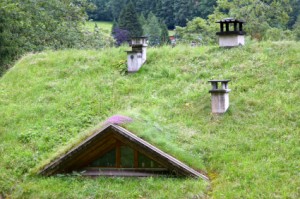 Green roofs, or rooftop gardens, refer to incorporating plants into a building’s roofing system.
Green roofs, or rooftop gardens, refer to incorporating plants into a building’s roofing system.
There are two basic types of green roofs:
- Intensive – an accessible roof with trees, shrubs and other plantings. These require more design, construction and maintenance, but provide greater benefits.
- Extensive – an inaccessible roof with a thin layer of soil and vegetation. These are best for retrofits where loading is a major concern. (1)
Green roofs provide a multitude of benefits, including some significant climate change-related advantages.
- Energy savings – In winter, the added insulation provided by a green roof keeps buildings warmer. In summer, greenery on a house can cool it by absorbing water and evaporating it. A 20 cm growing medium with a thick layer of plants has an insulating value comparable to R20. (2)
- Urban heat island – This phenomenon results in city temperatures of up to 8ºC warmer than areas outside the city. By providing shade and evapotranspiration, green roofs can reduce the urban heat island, although only if their usage is widespread. (3)
Other benefits include:
- increased storm water retention
- improved air quality
- improved aesthetics
- potential for increased biodiversity
- sound insulation
- food production potential
- an extended life for the roof membrane, as it is protected from hot and cold extremes and has reduced exposure to harmful UV radiation
A significant barrier to building a green roof is the higher costs up front from increased material and labour requirements. There are currently a limited number of contractors doing green roofs which also drive up costs. Further barriers include safety concerns and extra maintenance requirements. (4)




